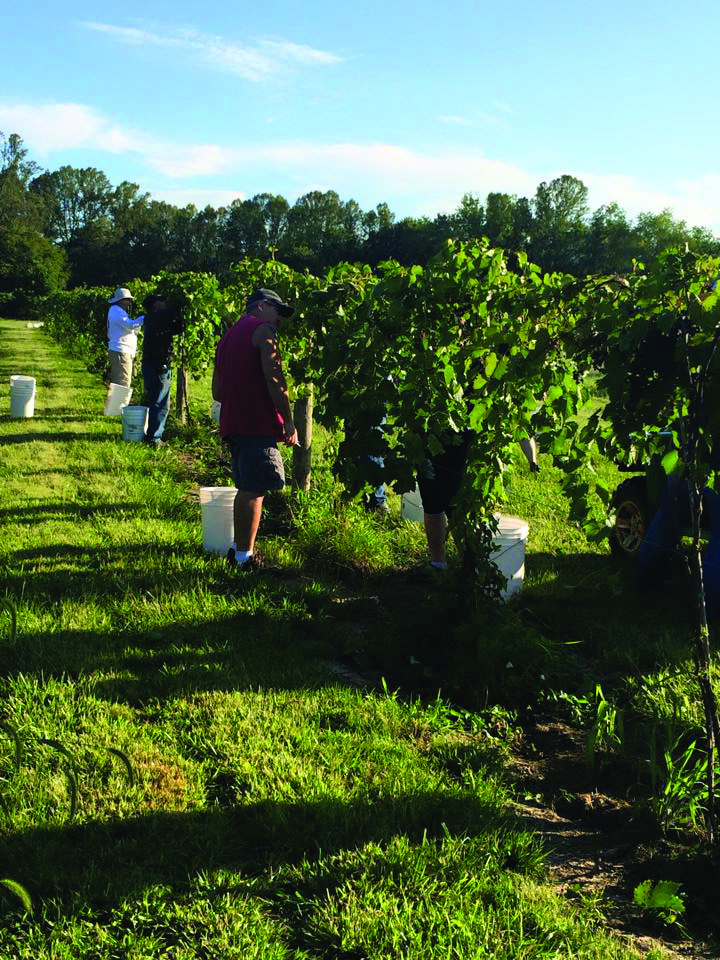
After a slow start in 2008, the Davidson family is finally producing all of its wine on site.
Just an Old Cattle Farm
You could say that Max and Loris Davidson’s legacy is growing in spirit. The now-deceased patriarch and matriarch once operated a cattle farm for over 30 years on a 110-acre plot of land in Logan. Hocking Hills Winery and its vineyard now operates on that land. And the business owners are the direct descendents of the couple.
“All my family members are investors,” says CEO and winemaker of Hocking Hills Winery Blaine Davidson, Max and Loris’s grandson. “My parents are all owners. I, my wife, brother and sister-in-law are the managers. We [four] run it on a day-to-day basis, but if we are doing something like bottling or picking grapes or anything like that, the whole rest of the family is involved.”
- Blaine’s wife, Allison, is the tasting room manager.
- His brother, Drew, serves as CFO.
- Drew’s wife, Laura, takes care of human resources.
By 2008, Blaine’s grandparents had passed away and the mostly hay-producing farm—in their old age cattle became too much to manage—was left to the rest of the family. They knew they wanted to keep the land agricultural, but do something different. A vineyard was chosen, and the rest is history.
Vineyard Venture
The venture has always been family-oriented, and they planted their first 600 grapevines in May 2008. Then, Blaine and Allison were living in Columbus, where their full-time jobs were located. The couple commuted to Logan several nights during the week and every weekend to tend to the grapes. “Basically, during the months of May through November, the plants need touched at least once a week,” Allison says.
“Touching” the plants entails pruning and training vines, thinning clusters of grapes and pulling off excess leaves.
The couple soon realized the need to be around the vineyard more, and in February 2009, they moved to Logan and commuted to work. Last October, Blaine left his job with Nationwide Insurance to make managing the winery his full-time job.
Today the vineyard holds about 2,000 vines, and the winery employs two part-time workers to maintain the vineyard.
For the first few years of business, the Davidson’s sold their grapes to other local wineries, like Shade Winery in Pomeroy.
Winery Time
Blaine says starting the winery was an idea from the beginning, but wasn’t a serious thought until 2011. By 2013, the family had the money to make that dream a reality, and the planning began.
When doors opened for the winery’s April 4 grand opening, the experience was surreal for the family. “It was a great feeling to say we’ve made it this far, and to say that we used to be a cattle field and now here we are with our winery,” Blaine says.
The winery has yet to sell wine 100 percent produced on site. It opened with some wines that were produced from its own grapes, but crushed at Shade. Other grapes and juices were imported from California and Chile, though the whole fermentation process and bottling occurred at the winery.
At the time of the opening wine’s production, the winery didn’t have all the necessary equipment, and it did not have a full yield of grapes due to issues like birds and frigid winters damaging vines. Since, the grapes have been netted to keep animals from feeding, and the plants are rebounding from damaging winters.
In August, the family harvested Frontenac grapes, which produce a red wine. They will be made into the winery’s first wine produced 100 percent—from the vineyard to the bottle—on site. “It was amazing to bring them over here, crush them and put them through the whole process and put them through our tanks,” Allison says.
It will be available for purchase by the summer of 2015
The winery opened with 6,000 gallons of wine, and the Davidsons’ grapes accounted for about 10 percent of that. It is the winery’s goal to reach a 50-50 ratio between grapes it grows and imports.
The vineyard’s current plot cannot produce enough grapes to sustain the traffic and sales the winery receives. Additionally, Ohio’s climate cannot support growing European-variety grapes like Cabernets, Pinot Grigios and Pinot Noirs.
Blaine wants annual wine production to reach 60,000 gallons, and he foresees building a restaurant and meeting hall on the vineyard property. And if all goes well, the winery and its accessories will be around for generations of Davidsons to manage.